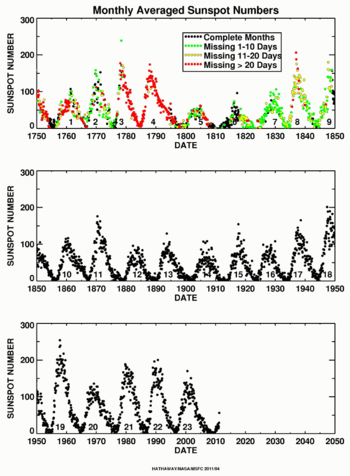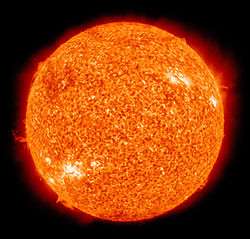Wolf number

The Wolf number (also known as the International sunspot number, relative sunspot number, or Zürich number) is a quantity that measures the number of sunspots and groups of sunspots present on the surface of the sun.
History
The idea of computing sunspot numbers was originated by Rudolf Wolf in 1848[1] in Zurich, Switzerland and, thus, the procedure he initiated bears his name (or place). The combination of sunspots and their grouping is used because it compensates for variations in observing small sunspots.
This number has been collected and tabulated by researchers for over 150 years.[2] They have found that sunspot activity is cyclical and reaches its maximum around every 9.5 to 11 years.[3] This cycle was first noted by Heinrich Schwabe in 1843.
Due to weather and researcher unavailability, "the" sunspot count is actually an average of observations by multiple people in multiple locations with different equipment, with a scaling factor k assigned to each observer to compensate for their differing ability to resolve small sunspots and their subjective division of groups of sunspots.[4]
The relative sunspot number is computed using the formula (collected as a daily index of sunspot activity):
where
- is the number of individual spots,
- is the number of sunspot groups, and
- is a factor that varies with location and instrumentation (also known as the observatory factor or the personal reduction coefficient ).[5]
Revision
Since 1 July 2015 a revised and updated list of the sunspot numbers has been made available.[4][6] The biggest difference is an overall increase by a factor of 1.6 to the entire series. Traditionally, a scaling of 0.6 was applied to all sunspot counts after 1893, to compensate for Alfred Wolfer's better equipment, after taking over from Wolf. This scaling has been dropped from the revised series, making modern counts closer to their raw values. Also, counts were reduced slightly after 1947 to compensate for bias introduced by a new counting method adopted that year, in which sunspots are weighted according to their size.[4]
However, alternative (group) sunspot number series exist [7][8][9][10] suggesting different behavior of sunspot activity before the 20th century. Thus, the solar variability before the 20th centuries remains quite uncertain.[11]
See also
References
- ↑ "The Sun - History". 2001-11-25. Retrieved 2012-01-08.
- ↑ SIDC, RWC Belgium, World Data Center for the Sunspot Index, Royal Observatory of Belgium, 'year(s)-of-data'.
- ↑ Using data from SIDC for the last 300 years and running a fast FFT function on the data gives an average maximum at 10.4883 years/cycle.
- 1 2 3 Clette, Frédéric; Svalgaard, Leif; Vaquero, José M.; Cliver, Edward W. "Revisiting the Sunspot Number". Space Science Reviews. 186 (1–4): 35–103. arXiv:1407.3231. Bibcode:2014SSRv..186...35C. doi:10.1007/s11214-014-0074-2. ISSN 0038-6308.
On average, the observed sunspot number after 1945 is a factor 1.21 higher than the expected value, again showing the influence of the weighting of sunspots according to size, coinciding with the tenure of Waldmeier
- ↑ personal reduction coefficient K
- ↑ Switching to the new Sunspot Number (1 July 2015)
- ↑ Lockwood; et al. (2014). "Centennial variations in sunspot number, open solar flux, and streamer belt width: 1. Correction of the sunspot number record since 1874". J. Geophys. Res. Space Phys. 119: 5172–5182. Bibcode:2014JGRA..119.5172L. doi:10.1002/2014JA019970.
- ↑ Svalgaard, Schatten (2016). "Reconstruction of the sunspot group number: the backbone method". Solar Physics. 291: 2653. arXiv:1506.00755. Bibcode:2016SoPh..291.2653S. doi:10.1007/s11207-015-0815-8.
- ↑ Usoskin; et al. (2016). "A new calibrated sunspot group series since 1749: statistics of active day fractions". Solar Physics. 291: 2685–2708. arXiv:1512.06421. Bibcode:2016SoPh..291.2685U. doi:10.1007/s11207-015-0838-1.
- ↑ Chatzistergos; et al. (2017). "New reconstruction of the sunspot group numbers since 1739 using direct calibration and "backbone" methods". Astron. Astrophys. 602: A69. arXiv:1702.06183. Bibcode:2017A&A...602A..69C. doi:10.1051/0004-6361/201630045.
- ↑ Usoskin, I. (2017). "A history of solar activity over millennia". Living Reviews in Solar Physics. 14: 3. Bibcode:2017LRSP...14....3U. doi:10.1007/s41116-017-0006-9.
